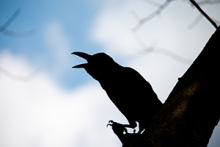Article
In some versions of Navajo traditional medicine, the crowbill is associated with the Enemyway, a ceremonial that is sung to cure people from illness caused by coming into contact with an "enemy," typically someone or an experience outside the Navajo culture and traditional lifeways. The enemy individual could be a member of another tribe, or in more contemporary times, an Angloeuropean. The enemy experience could be going away to fight war, such as World War Two, or to boarding school or university off the reservation. The symbolic scalp is collected during a ritualized warpath prior to the ceremony, brought to the place of healing without being touched, and kept out of sight until it is time to be destroyed.
At the close of the ceremonial, the patient who is being cured takes the bill of a mountain raven, or an imitation crowbill made from juniper, and mock attacks the ashes of the symbolic enemy scalp after it has been burned, thus symbolizing the defeat of the enemy causing unbalance and associated illness in the patient, thereby restoring the patience to harmony and equilibrium.
"Corvus macrorhynchos, large-billed crow, Lumpini Park, Thailand, February 14, 2014" by Rushen is licensed under CC BY-SA.
Manuscripts
References
Frisbie, Charlotte Johnson
1980 Approach to the Ethnography of Navajo Ceremonial Performance. Ethnography of
Musical Performance, Norma Mcleod and Marcia Herndon, eds. Norwood: Norwood
Editions.
Haile, Berard
1938 Origin Legend of the Navaho Enemyway. New Haven: Yale University Press.
Hirschfelder, Arlene, and Paulette Molin
2000 Evil Way. Encyclopedia of Native American Religions, Updated Edition. New York:
Facts On File, Inc.
Wyman Leland
1983 Navajo Ceremonial System. In Handbook of North American Indians, Vol. 10. A.
Ortiz, ed. Pp. 536-537. Washington: Smithsonian Institution Washington.

